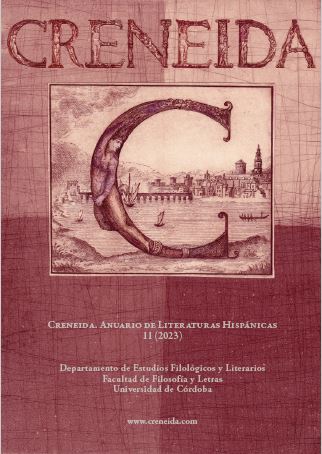Dos monedas: el yo femenino y la otredad en el viaje como parte del bildungsroman en el cómic
Contenido principal del artículo
Resumen
El presente artículo aborda el cómic Dos monedas (2019) de Núria Tamarit, que gira en torno al proceso de maduración de la adolescente Mar durante su estancia en Senegal. Luego de exponer las características propias de la autoficción en el cómic de autora, procuraremos demostrar cómo esta novela gráfica rehúye dicho recurso, aun basándose en varios episodios de la biografía de la valenciana. En segundo lugar, sondeamos la instrumentalización de la protagonista para presentar la obra como un Bildungsroman que reflexiona sobre el viaje y la otredad no solo como proceso de maduración y rito de paso liminoide, sino también como reivindicación de África.
Descargas
Datos de publicación
Perfil evaluadores/as N/D
Declaraciones de autoría
- Sociedad académica
- Creneida. Anuario de Literaturas Hispánicas
Detalles del artículo

Esta obra está bajo una licencia internacional Creative Commons Atribución-NoComercial-SinDerivadas 4.0.
Avisos de derechos de autor propuestos por Creative Commons
1. Política propuesta para revistas que ofrecen acceso abierto
Aquellos autores/as que tengan publicaciones con esta revista, aceptan los términos siguientes:- Los autores/as conservarán sus derechos de autor y garantizarán a la revista el derecho de primera publicación de su obra, el cuál estará simultáneamente sujeto a la Licencia de reconocimiento de Creative Commons que permite a terceros compartir la obra siempre que se indique su autor y su primera publicación esta revista.
- Los autores/as podrán adoptar otros acuerdos de licencia no exclusiva de distribución de la versión de la obra publicada (p. ej.: depositarla en un archivo telemático institucional o publicarla en un volumen monográfico) siempre que se indique la publicación inicial en esta revista.
- Se permite y recomienda a los autores/as difundir su obra a través de Internet (p. ej.: en archivos telemáticos institucionales o en su página web) antes y durante el proceso de envío, lo cual puede producir intercambios interesantes y aumentar las citas de la obra publicada. (Véase El efecto del acceso abierto).
Citas
Alberca, Manuel, El pacto ambiguo, Madrid, Biblioteca Nueva, 2007.
Angux y Núria Tamarit, Avery’s Blues, Madrid, Dibbuks, 2016.
Barry, Linda, One! Hundred! Demons!, Montreal, Drawn Quarterly, 2017.
Beaton, Kate, Hark! A Vagrant, Londres, Random House, 2011
Bezhanova, Olga, “La angustia de ser mujer en el Bildungsroman femenino: Varsavsky, Boullosa y Grandes”, Espéculo: Revista de Estudios Literarios, XLI (2019) [en línea], <http://webs.ucm.es/info/especulo/numero41/bromfeme.html>, (consultado el 03/04/2022)
Binswanger, Ludwig, Being-in-the-World: Selected Papers of Ludwig Binswanger, Nueva York, Basic Books, 1963.
Borham Puyal, Miriam, Contemporary Rewritings of Liminal Women, Londres, Routledge, 2020. DOI: https://doi.org/10.4324/9780429297823
Calin, Cassandra, Still Just Kidding: A Collection of Art, Comics and Musings, Worcerster, 3DTotal Publishing, 2018.
Constenla, Tereixa, “La autoficción manda en el comic”, El País [en línea], 19/12/2020: <https://elpais.com/babelia/2020-12-18/la-autoficcion-manda-en-el-comic.html> (consultado el 15/03/2022).
Deveney, Jean-Christophe y Núria Tamarit, Giganta, Barcelona, Norma Editorial, 2021.
Doubrovsky, Serge, Fils, París, Gallimard, 1977.
Echeverría, Javier, Cosmopolitas domésticos, Barcelona, Anagrama, 1995.
Fandiño Barros, Yolanda Alicia, “La otredad y la discriminación de géneros”, Advocatus, XXIII (2014), pp. 49-57. DOI: https://doi.org/10.18041/0124-0102/a.23.4968
Garsán, Carlos, “Núria Tamarit confronta la ‘imagen catastrofista’ de África en Dos monedas”, CulturPlaza [en línea], 03/04/2019: <https://valenciaplaza.com/nuria-tamarit-confronta-la-imagen-catastrofista-de-africa-en-dos-monedas> (consultado el 15/03/2022).
Gennep, Arnold van, Rites de Passage, París, E. Nourry, 1909.
Giner Bou, Miguel Ángel, Núria Tamarit y Xulia Vicente, Anna Dédalus Detectiu. El misteri de la mansió cremada, Picassent, Andana Editorial, 2015.
Goldsmith, Kenneth, “If It Doesn’t Exist on the Internet, It Doesn’t Exist”, University of Pennsylvania [en línea]: https://writing.upenn.edu/epc/authors/goldsmith/if_it_doesnt_exist.html (consultado el 04/04/2022).
Guzmán Tinajero, Alfredo Carlos, Figuraciones del yo en el cómic contemporáneo, Barcelona, Universitat Autònoma de Barcelona, 2017 [tesis doctoral].
Havighurst, Robert J., Developmental Tasks and Education, 1972, Nueva York, McKay.
Hernando, David, “Voces que cuentan - Introducción”, en Voces que cuentan. Una antología, VV.AA., Barcelona, Planeta Cómic, 2021, pp. 6-7.
Hughes, Janette y Alyson E. King, “Dual Pathways to Expression and Understanding: Canadian Coming-of-Age Graphic Novels”, Children’s Literature in Education, XLI (2010), pp. 64-84. DOI: https://doi.org/10.1007/s10583-009-9098-8
Krotz, Esteban, “Poder, símbolos y movilizaciones: sobre algunos problemas y perspectivas de la Antropología Política”, Nueva Antropología. Revista de Ciencias Sociales, 31 (1986), pp. 7-22.
López Gallego, Manuel, “Bildungsroman: historias para crecer”, Tejuelo. Didáctica de la lengua y la literatura. Educación, XVIII (2013), pp. 62-75.
Magnet Colomer, Jordi, “El debilitamiento del yo en el tardocapitalismo y la nueva propaganda fascista”, Oxímora. Revista Internacional de Ética y Política, XVIII (2021), pp. 37-55. DOI: https://doi.org/10.1344/oxi.2021.i0.32280
McCloud, Scott, Reinventing Comics: How Imagination and Technology Are Revolutionizing an Art Form, Nueva York, Paradox Press, 2000.
Merleau-Ponty, Maurice, La fenomenología y las ciencias del hombre, Buenos, Aires, Prometeo Libros, 2001.
Ralphs, Matt y Núria Tamarit, Tiempos de brujas y hechiceros, Madrid, Edelvives, 2021.
Schwarz, Gretchen y Christina Crenshaw, “Old Media, New Media: The Graphic Novel as Bildungsroman”, Journal of Media Literacy Education, III, 1 (2011), pp. 47-53. DOI: https://doi.org/10.23860/jmle-3-1-13
Sibilia, Paula, La intimidad como espectáculo, El Salvador: Fondo de Cultura Económica, 2008.
Tamarit, Núria, Dos monedas, Barcelona, La Cúpula, 2019
Tamarit, Núria, Le conte du genévrier, París, Les Aventuries de l’Étrange, 2020.
Thomas, Emily, The Meaning of Travel, Oxford, Oxford University Press, 2020.
Tisseron, Serge, L’intimité superexposée, París, Ramsay, 2001
Turner, Victor, “Liminal to Liminoid in Play, Flow, and Ritual: An Essay in Comparative Symbology”, Rice University Studies, LX, 3 (1974), pp. 53-92.
Vargas Llosa, Mario, “El arte de mentir”, El País [online] 25/07/1984: <https://elpais.com/diario/1984/07/25/opinion/459554410_850215.html> (consultado el 15/03/2022).
Versaci, Rocco, This Book Contains Graphic Language: Comics as Literature, Nueva York, Continuum (p. 16).
VV. AA. (2021). Voces que cuentan. Una antología. Barcelona: Planeta Cómic.





